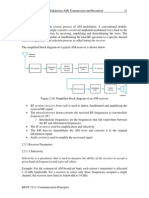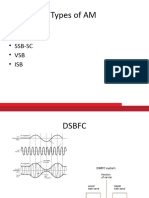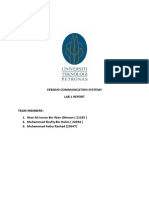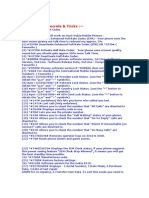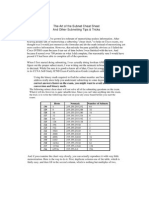Chapter 3 Part 2 PDF
Uploaded by
Khairil Azwan TugimanChapter 3 Part 2 PDF
Uploaded by
Khairil Azwan TugimanChapter 3: Single-Sideband (SSB) Communication Systems 51
3.5 SSB Receivers
3.5.1 SSB BFO Receiver
Figure 3.12 shows the block diagram for a simple noncoherent SSB BFO receiver:
Figure 3.12: Noncoherent SSB BFO receiver
• In a receiver, the input signal (suppressed or reduced carrier and one sideband) is
amplified and then mixed with the RF local oscillator frequency to produce
intermediate frequency
• The output from the RF mixer is then goes through further amplification and band
reduction prior to second mixer.
• The output from the IF amplifier stage is then mixed (heterodyned) with beat
frequency oscillator (BFO) frequency
The BFO frequency is equal to IF carrier frequency. Thus, the difference between
the IF and the BFO frequencies is the information signal
I.e. the output from the IF mixer is the sum and difference frequencies between
the IF and the beat frequency. The difference frequency band is the original input
information
• The receiver is noncoherent because the RF oscillator and BFO signals are not
synchronized to each other and to the oscillators in the transmitter
Consequently, any difference between the transmit and receive local oscillator
frequencies produces a frequency offset error in the demodulated information
signal
• The RF mixer and IF mixer are product detectors. A product detector and
balanced (product) modulator are essentially the same circuit
BENT 3753: Communication Principles
Chapter 3: Single-Sideband (SSB) Communication Systems 52
3.5.2 Coherent SSB BFO receiver
The block diagram for a coherent SSB BFO receiver is shown below:
Figure 3.13: Coherent SSB BFO receiver
This receiver is identical to the previous BFO receiver except that the LO and BFO
frequencies are synchronized to the carrier oscillators in the transmitter
• The carrier recovery circuit is a narrowband PLL that tracks the pilot carrier in the
SSBRC signal
• This recovered carrier is then used to generate coherent local oscillator
frequencies (RF local oscillator frequency and BFO frequency) in the synthesizer
• Any minor changes in the carrier frequency in the transmitter are compensated for
in the receiver, and the frequency offset error is eliminated
(Refer examples 6.2 and 6.3 in the textbook for further explanations)
3.5.3 SSB Envelope Detection Receiver
Figure 3.14 shows a SSB receiver that uses synchronous carriers and envelope detection
to demodulate the received signals:
• As before, the reduced carrier pilot is detected, separated from the demodulated
spectrum and regenerated in the carrier recovery circuit
• This regenerated carrier is used in the frequency synthesizer to supply the receiver
with frequency coherent local oscillators
• The received RF signal is mixed down to IF in the first detector (RF mixer)
• A regenerated IF carrier is then added to the IF spectrum in the linear summer,
producing a SSBFC envelope
• The envelope is then demodulated using a conventional peak diode detector to
produce the original information signal
BENT 3753: Communication Principles
Chapter 3: Single-Sideband (SSB) Communication Systems 53
Figure 3.14: SSB envelope detection receiver
3.6 SSB and Frequency-Division Multiplexing
The most common application of SSB (especially SSBSC) is frequency-division
multiplexing (FDM) due to the bandwidth and power efficiencies of SSB system
Frequency-division multiplexing is an analog method of combining two or more analog
sources that originally occupied the same frequency band in such a manner that the
channels do not interfere with each other
Figure 3.15 shows a simple FDM system where four 5-kHz channels are frequency-
division multiplexed into a single 20-kHz channel
Figure 3.15: SSBSC FDM system
BENT 3753: Communication Principles
Chapter 3: Single-Sideband (SSB) Communication Systems 54
• Channel 1 signals modulate a 100 kHz carrier in a balanced modulator. The
output is a DSBSC with a bandwidth of 10 kHz
• The DSBSC wave then passed through BPF producing a SSBSC signal occupying
the frequency band between 100 kHz and 105 kHz
• Channel 2 signals modulate a 105 kHz carrier producing a DSBSC wave that is
converted to SSBSC by passing it through a BPF
• The output from the BPF occupies the frequency band between 105 kHz and 110
kHz
• Similar process is used to convert channel 3 and channel 4 signals to the
frequency bands 110 kHz to 115 kHz and 115 kHz to 120 kHz, respectively
• The combined frequency spectrum produced by combining the outputs from four
filters is shown below:
Figure 3.16: Output frequency spectrum
• The total combined bandwidth is equal to 20 kHz and each channel occupies a
different 5 kHz portion of the total 20 kHz bandwidth
• FDM is used extensively to combine many relatively narrowband channels into a
single, composite wideband channel without the channels interfering with each
other, such as in public telephone systems
BENT 3753: Communication Principles
You might also like
- TriPac EVOLUTION Diagnostic Manual 55739-19-OD Rev 0 (08-13)86% (21)TriPac EVOLUTION Diagnostic Manual 55739-19-OD Rev 0 (08-13)341 pages
- A Discovery of Witches Deborah E. Harkness84% (64)A Discovery of Witches Deborah E. Harkness283 pages
- The Hacker Playbook 1 - Practical Guide To Penetration Testing91% (11)The Hacker Playbook 1 - Practical Guide To Penetration Testing308 pages
- CompTIA Network+ Certification Passport, 7th Edition Exam N10 008100% (6)CompTIA Network+ Certification Passport, 7th Edition Exam N10 008449 pages
- American Survival Guide, Prepper Survival Field Manual - Spring 2017100% (12)American Survival Guide, Prepper Survival Field Manual - Spring 2017132 pages
- Universal Codes For Cell Phones and Advanced Tricks80% (5)Universal Codes For Cell Phones and Advanced Tricks30 pages
- Cannibalism Blood Drinking High Adept Satanism by Kerth Barker Z Liborgepub100% (5)Cannibalism Blood Drinking High Adept Satanism by Kerth Barker Z Liborgepub194 pages
- AMA 454 Topic 2: FNU School of Aviation 1No ratings yetAMA 454 Topic 2: FNU School of Aviation 139 pages
- 4.8 FM Receivers: Limiter, Frequency DiscriminatorNo ratings yet4.8 FM Receivers: Limiter, Frequency Discriminator8 pages
- Study On Equalizers: Anik Sengupta Sohom DasNo ratings yetStudy On Equalizers: Anik Sengupta Sohom Das11 pages
- Transmitters and Receivers: A Session For "Electronics and Telecommunications" A Fairfield University E-CourseNo ratings yetTransmitters and Receivers: A Session For "Electronics and Telecommunications" A Fairfield University E-Course19 pages
- SystemLevel Design and Simulation of A Bluetooth ReceiverNo ratings yetSystemLevel Design and Simulation of A Bluetooth Receiver10 pages
- FM Detector With PLL For A Direct-Conversion ReceiverNo ratings yetFM Detector With PLL For A Direct-Conversion Receiver2 pages
- AIM To Study Frequency Division Multiplexing and Demultiplexing APPARATUS:-FDMD Trainer Kit, CRO, Probes Patch Cords Etc. Circuit DiagramNo ratings yetAIM To Study Frequency Division Multiplexing and Demultiplexing APPARATUS:-FDMD Trainer Kit, CRO, Probes Patch Cords Etc. Circuit Diagram10 pages
- Experiment 9 - Frequency Shift Keying (FSK) and Amplitude Shift KeyingNo ratings yetExperiment 9 - Frequency Shift Keying (FSK) and Amplitude Shift Keying5 pages
- Chapter 5: Frequency Modulation Transmission: EET-223: RF Communication Circuits Walter LaraNo ratings yetChapter 5: Frequency Modulation Transmission: EET-223: RF Communication Circuits Walter Lara35 pages
- AM Independent and Vestigial Sideband SummaryNo ratings yetAM Independent and Vestigial Sideband Summary6 pages
- Types of AM: - DSB-FC - DSB-SC - SSB-SC - VSB - IsbNo ratings yetTypes of AM: - DSB-FC - DSB-SC - SSB-SC - VSB - Isb44 pages
- B.SC Electronics D2 P4 (2020) SolutionsNo ratings yetB.SC Electronics D2 P4 (2020) Solutions15 pages
- Design and Principle of Operation: Circuit DescriptionNo ratings yetDesign and Principle of Operation: Circuit Description3 pages
- Communication System TC-307: Lecture 10, Week 4 Course Instructor: Nida NasirNo ratings yetCommunication System TC-307: Lecture 10, Week 4 Course Instructor: Nida Nasir86 pages
- 6.Single-Sideband Communications SystemsNo ratings yet6.Single-Sideband Communications Systems22 pages
- Filter Bank: Insights into Computer Vision's Filter Bank TechniquesFrom EverandFilter Bank: Insights into Computer Vision's Filter Bank TechniquesNo ratings yet
- Chapter 2: Linear Modulation: Double-Sideband Full Carrier ConventionalNo ratings yetChapter 2: Linear Modulation: Double-Sideband Full Carrier Conventional7 pages
- 6.4 Digital Transmission: Pulse Amplitude Modulation (PAM) and Pulse Code Modulation (PCM)No ratings yet6.4 Digital Transmission: Pulse Amplitude Modulation (PAM) and Pulse Code Modulation (PCM)13 pages
- Chapter 6: Introduction To Digital CommunicationNo ratings yetChapter 6: Introduction To Digital Communication11 pages
- Chapter 5: Noise: 5.1 Noise - Representation, Types and SourcesNo ratings yetChapter 5: Noise: 5.1 Noise - Representation, Types and Sources4 pages
- Ham Radio For The New Ham What To Do The Minute You Get Your Amateur Radio License - Stan Merrill50% (2)Ham Radio For The New Ham What To Do The Minute You Get Your Amateur Radio License - Stan Merrill137 pages
- Ham Radio An Easy Guide For Beginners - Steve Markelo100% (4)Ham Radio An Easy Guide For Beginners - Steve Markelo10 pages
- GMC S15 Workshop Manual (S15-T15 Jimmy 4WD V6-4.3L VIN W (1996-1999) )No ratings yetGMC S15 Workshop Manual (S15-T15 Jimmy 4WD V6-4.3L VIN W (1996-1999) )18,212 pages
- Domain Name System Explained Guide. DNS Guide100% (1)Domain Name System Explained Guide. DNS Guide26 pages
- q.16) Operation of Positive and Negative ClippersNo ratings yetq.16) Operation of Positive and Negative Clippers15 pages
- Cs578: Internet of Things: Iot FrameworksNo ratings yetCs578: Internet of Things: Iot Frameworks18 pages
- The State-of-the-Art of Silicon-on-Sapphire CMOS RF SwitchesNo ratings yetThe State-of-the-Art of Silicon-on-Sapphire CMOS RF Switches4 pages
- 8770 3.2.8 Am Accountvoipticketscollect 8al90709usad 1 en0% (1)8770 3.2.8 Am Accountvoipticketscollect 8al90709usad 1 en62 pages
- Power Electronics For Very High Power ApplicationsNo ratings yetPower Electronics For Very High Power Applications6 pages
- Apple laptop A1466 boot sequence repair processNo ratings yetApple laptop A1466 boot sequence repair process9 pages
- Computing - EOTT - 2 - Programming RObots and SBCNo ratings yetComputing - EOTT - 2 - Programming RObots and SBC2 pages
- Matsushita Toyota Yaris Verso Cn-Ts0270a Ts0272a SMNo ratings yetMatsushita Toyota Yaris Verso Cn-Ts0270a Ts0272a SM26 pages
- Jim Butterfield - Machine Language For The Commodore 64 and Other Commodore Computers (1984, Prentice-Hall Publishing)No ratings yetJim Butterfield - Machine Language For The Commodore 64 and Other Commodore Computers (1984, Prentice-Hall Publishing)350 pages
- Chapter Four Description of Automatic Water Tank Level Control SystemNo ratings yetChapter Four Description of Automatic Water Tank Level Control System14 pages
- Mca 1 Sem Computer Organization Architecture Kca 105 2023No ratings yetMca 1 Sem Computer Organization Architecture Kca 105 20232 pages
- NPTEL - Week - 8 - v1 reevalution assignment solutionNo ratings yetNPTEL - Week - 8 - v1 reevalution assignment solution7 pages
- Course Title: Digital Systems: Course No: CSE-105 Credit: 3 Contact Hours: 3 Total Marks: 100No ratings yetCourse Title: Digital Systems: Course No: CSE-105 Credit: 3 Contact Hours: 3 Total Marks: 1007 pages
- Micro-Project: Title: Sort The Array in Descending Order DescriptionNo ratings yetMicro-Project: Title: Sort The Array in Descending Order Description7 pages
- AVM-2000 High Sensitivity Analog DC Voltmeter/Nullmeter: Instruction and Service ManualNo ratings yetAVM-2000 High Sensitivity Analog DC Voltmeter/Nullmeter: Instruction and Service Manual40 pages
- Single Phase Low-Cost Energy Meter: IMS System Lab & Technical MarketingNo ratings yetSingle Phase Low-Cost Energy Meter: IMS System Lab & Technical Marketing16 pages
- TriPac EVOLUTION Diagnostic Manual 55739-19-OD Rev 0 (08-13)TriPac EVOLUTION Diagnostic Manual 55739-19-OD Rev 0 (08-13)
- The Hacker Playbook 1 - Practical Guide To Penetration TestingThe Hacker Playbook 1 - Practical Guide To Penetration Testing
- CompTIA Network+ Certification Passport, 7th Edition Exam N10 008CompTIA Network+ Certification Passport, 7th Edition Exam N10 008
- American Survival Guide, Prepper Survival Field Manual - Spring 2017American Survival Guide, Prepper Survival Field Manual - Spring 2017
- Universal Codes For Cell Phones and Advanced TricksUniversal Codes For Cell Phones and Advanced Tricks
- Cannibalism Blood Drinking High Adept Satanism by Kerth Barker Z LiborgepubCannibalism Blood Drinking High Adept Satanism by Kerth Barker Z Liborgepub
- 4.8 FM Receivers: Limiter, Frequency Discriminator4.8 FM Receivers: Limiter, Frequency Discriminator
- Transmitters and Receivers: A Session For "Electronics and Telecommunications" A Fairfield University E-CourseTransmitters and Receivers: A Session For "Electronics and Telecommunications" A Fairfield University E-Course
- SystemLevel Design and Simulation of A Bluetooth ReceiverSystemLevel Design and Simulation of A Bluetooth Receiver
- FM Detector With PLL For A Direct-Conversion ReceiverFM Detector With PLL For A Direct-Conversion Receiver
- AIM To Study Frequency Division Multiplexing and Demultiplexing APPARATUS:-FDMD Trainer Kit, CRO, Probes Patch Cords Etc. Circuit DiagramAIM To Study Frequency Division Multiplexing and Demultiplexing APPARATUS:-FDMD Trainer Kit, CRO, Probes Patch Cords Etc. Circuit Diagram
- Experiment 9 - Frequency Shift Keying (FSK) and Amplitude Shift KeyingExperiment 9 - Frequency Shift Keying (FSK) and Amplitude Shift Keying
- Chapter 5: Frequency Modulation Transmission: EET-223: RF Communication Circuits Walter LaraChapter 5: Frequency Modulation Transmission: EET-223: RF Communication Circuits Walter Lara
- Types of AM: - DSB-FC - DSB-SC - SSB-SC - VSB - IsbTypes of AM: - DSB-FC - DSB-SC - SSB-SC - VSB - Isb
- Design and Principle of Operation: Circuit DescriptionDesign and Principle of Operation: Circuit Description
- Communication System TC-307: Lecture 10, Week 4 Course Instructor: Nida NasirCommunication System TC-307: Lecture 10, Week 4 Course Instructor: Nida Nasir
- Filter Bank: Insights into Computer Vision's Filter Bank TechniquesFrom EverandFilter Bank: Insights into Computer Vision's Filter Bank Techniques
- Learn Amateur Radio Electronics on Your SmartphoneFrom EverandLearn Amateur Radio Electronics on Your Smartphone
- Chapter 2: Linear Modulation: Double-Sideband Full Carrier ConventionalChapter 2: Linear Modulation: Double-Sideband Full Carrier Conventional
- 6.4 Digital Transmission: Pulse Amplitude Modulation (PAM) and Pulse Code Modulation (PCM)6.4 Digital Transmission: Pulse Amplitude Modulation (PAM) and Pulse Code Modulation (PCM)
- Chapter 5: Noise: 5.1 Noise - Representation, Types and SourcesChapter 5: Noise: 5.1 Noise - Representation, Types and Sources
- Ham Radio For The New Ham What To Do The Minute You Get Your Amateur Radio License - Stan MerrillHam Radio For The New Ham What To Do The Minute You Get Your Amateur Radio License - Stan Merrill
- Ham Radio An Easy Guide For Beginners - Steve MarkeloHam Radio An Easy Guide For Beginners - Steve Markelo
- GMC S15 Workshop Manual (S15-T15 Jimmy 4WD V6-4.3L VIN W (1996-1999) )GMC S15 Workshop Manual (S15-T15 Jimmy 4WD V6-4.3L VIN W (1996-1999) )
- The State-of-the-Art of Silicon-on-Sapphire CMOS RF SwitchesThe State-of-the-Art of Silicon-on-Sapphire CMOS RF Switches
- 8770 3.2.8 Am Accountvoipticketscollect 8al90709usad 1 en8770 3.2.8 Am Accountvoipticketscollect 8al90709usad 1 en
- Power Electronics For Very High Power ApplicationsPower Electronics For Very High Power Applications
- Matsushita Toyota Yaris Verso Cn-Ts0270a Ts0272a SMMatsushita Toyota Yaris Verso Cn-Ts0270a Ts0272a SM
- Jim Butterfield - Machine Language For The Commodore 64 and Other Commodore Computers (1984, Prentice-Hall Publishing)Jim Butterfield - Machine Language For The Commodore 64 and Other Commodore Computers (1984, Prentice-Hall Publishing)
- Chapter Four Description of Automatic Water Tank Level Control SystemChapter Four Description of Automatic Water Tank Level Control System
- Mca 1 Sem Computer Organization Architecture Kca 105 2023Mca 1 Sem Computer Organization Architecture Kca 105 2023
- NPTEL - Week - 8 - v1 reevalution assignment solutionNPTEL - Week - 8 - v1 reevalution assignment solution
- Course Title: Digital Systems: Course No: CSE-105 Credit: 3 Contact Hours: 3 Total Marks: 100Course Title: Digital Systems: Course No: CSE-105 Credit: 3 Contact Hours: 3 Total Marks: 100
- Micro-Project: Title: Sort The Array in Descending Order DescriptionMicro-Project: Title: Sort The Array in Descending Order Description
- AVM-2000 High Sensitivity Analog DC Voltmeter/Nullmeter: Instruction and Service ManualAVM-2000 High Sensitivity Analog DC Voltmeter/Nullmeter: Instruction and Service Manual
- Single Phase Low-Cost Energy Meter: IMS System Lab & Technical MarketingSingle Phase Low-Cost Energy Meter: IMS System Lab & Technical Marketing
















